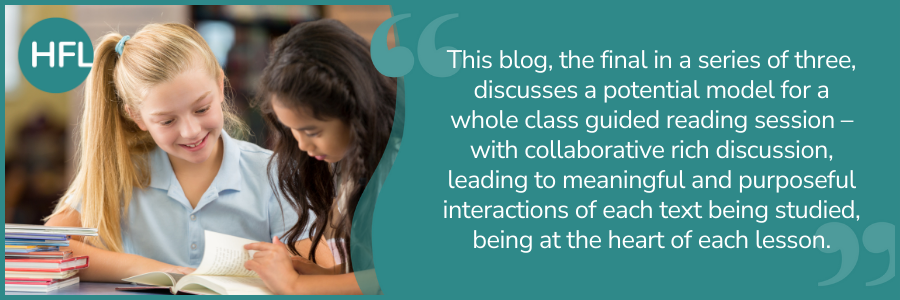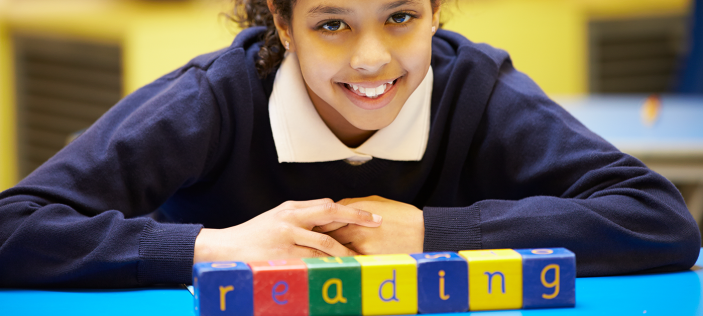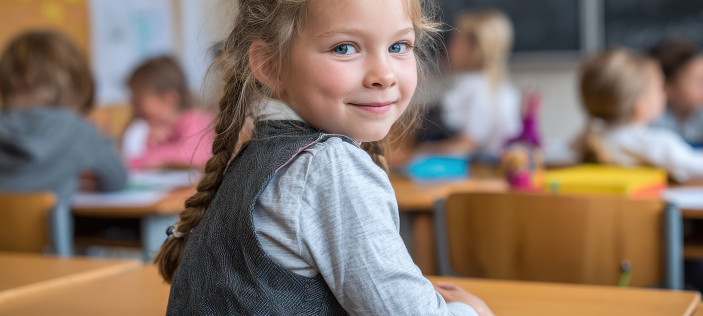
Hopefully you have read Part 1 and Part 2 of this blog, and you now feel ready to turn your attention to a possible structure for the whole class guided reading lesson itself. Here we will consider how we might balance the explicit teaching of comprehension strategies and development of rich discussion, leading to meaningful interactions with the text being studied. The guidance shared is just one example of what a whole class guided reading (WCGR) lesson could look like and can be shared and discussed with colleagues as a starting point for your own design, which should be evaluated regularly.
The importance of connection, metacognition and creating a mental model
Firstly, let’s consider how we want each child to feel in their reading lessons. We can all agree that reading lessons must feel worthwhile, motivational and engaging – and not just focusing on the teaching of reading itself; each child must feel like they are a reader. We should allow children to respond as readers, first and foremost, to connect what they have read with their own lives, to question and to wonder. If we don’t behave as authentic readers do, then we can potentially lose the opportunity to nurture children becoming lifelong readers, along with all of the benefits that will bring. As the reading framework states: ‘Reading lessons need to create readers, not just pupils who can read’ (p. 108). Here we can rely upon the brilliant work of Aidan Chambers (1991, reprinted in 2011, p. 165), who highlighted four key questions we can pose upon encountering any text:
- Was there anything you liked about this?
- Was there anything you disliked?
- Was there anything that puzzled you?
- Were there any patterns – any connections – that you noticed?
The last question, in particular, will set the class up perfectly for a more in-depth discussion (see below) later on in the lesson or during the course of study.
Secondly, let’s dispel the notion that we can teach generic comprehension skills, for example by dividing up these skills and teaching them separately. Essentially, reading lessons must be devised using the text in front of us, not a pre-determined generic skill. Shanahan (2018) states that ‘each text presents information in its own way, and reading comprehension is heavily bound up in the readers’ knowledge of the topic covered by the text.’ Inference, for example, is an outcome of reading. We can teach how to build inference via comprehension strategies, such as ensuring that we ask appropriate questions to check our understanding of the text. Shanahan (2018) states that: ‘Comprehension strategies are not about coming up with answers to particular kinds of questions, but they describe actions that may help a reader to figure out and remember the information from a text.’ Through modelling, explaining, scaffolding and then encouraging independent application of comprehension strategies, the children will be shown how to use this metacognition (thinking about their thinking) to check and, where necessary, repair their understanding of the text. Such strategies include:
- Activating and using background knowledge
- Generating and asking questions
- Making predictions
- Visualising
- Monitoring comprehension
- Summarising
As experienced readers, we draw upon these strategies all the time when reading, often subconsciously. A caveat here though – whilst it is important to model such strategies explicitly and encourage children to apply them, it is crucial that the children start to internalise these processes so that time is dedicated to rich discussion based on the content of the text (more on that later).
Let’s return to inference, which is the goal for comprehension to flourish. We build inference on a ‘local’ level (linking words and sentences) and a ‘global’ level (connecting across the whole text and beyond). We could liken this to an inverted triangle, where we might go from a macro level at the wide end of the triangle (how we feel about the text, what it reminds us of, what connections we make to other parts of the text, themes and plot, etc), moving down to the point - a micro level of zooming in to specific words and considering what they mean and why the author might have chosen them. In this way, as teachers, we can model this zooming in and out, because that is what good readers do. This inference making leads us to create a mental model (a representation, in our minds, of what is being described) of a specific text. The questions we ask within reading lessons therefore need to be text specific, not based on generic skills. They also need to be posed to promote thinking about the text, not for ‘assessing’ comprehension. The mental model we create is unique to each reader and their reading of the text. Our role in WCGR lessons is therefore to ensure that the children’s own mental models are as robust as possible - without looking for a ‘right’ or ‘wrong’ interpretation, but instead promoting curiosity and reflection.
Questioning that promotes elaboration and flexible thinking will support pupils to integrate new ideas and knowledge into their existing schema. It is a principal part of good reading teaching, alongside a teacher's explanations. To be as effective as possible, questions need to be text specific. Banks or lists of generic questions, perhaps found online, are unlikely to lead to deep thinking or rich discussion.
The Reading Framework, 2023. P. 118
How could we prepare for a whole class guided reading lesson?
To prepare for the lesson, you will want to think about where you want to read aloud, which sections of the text you want the children to re-read and which sections you might want them to read on or read further. Potentially challenging, interesting or technical vocabulary will need to be identified and decisions made on how you want to discuss those with the children. You might want to consider at which points you will want to stop and think aloud, using metacognitive talk to check and self-repair your own understanding of the text, and where you might want to stop and pose questions to the children. You will also want to consider where you might want to pause to explicitly model other comprehension strategies (such as visualising or summarising), ensuring that the balance is still firmly in favour of rich discussion to develop and deepen understanding of the text, whilst also not overly interrupting or spoiling the flow of the reading itself. This may all sound a little daunting, but over time and with practise, it will happen quite naturally. The questions you ask will also, over time, not need planning so carefully as they will be spontaneous and guided by the children’s responses.
What about written responses in whole class guided reading lessons?
Ultimately, any writing that takes place in the reading lesson should serve as a tool for critical thinking. Writing does not have to be an end-product of the lesson and it can be useful to incorporate low-stakes writing where children jot down their ideas onto whiteboards or in journals to help clarify their thinking. Large chunks of reading followed by a single block of writing can allow misunderstandings to spiral, so responses could be collected at different points of the lesson – in between stages of interpreting a text. Children should also be allowed the opportunity to go back and refine any written responses, based on their discussions and developing interpretation of the text.
What could the structure of a whole class guided reading lesson look like?
For the remainder of this blog, we can consider how repeated reading, layered discussion and comprehension strategies can be interwoven within a WCGR lesson to support the development of a robust mental model of the text. Please do refer back to Part 1 of this blog to consider how all children can access whole class guided reading lessons. Here is an example for the structure of a WCGR lesson in KS2, that you can use, adapt and refer to as you wish:
A lot of the thinking here borrows from the excellent ‘Reading Reconsidered’ (2016) by Doug Lemov et al, which posits layered reading as a tool for establishing and analysing meaning. Whilst it is not possible to delve into the huge complexities of the types of questioning, variations of comprehension strategies and nuances of lesson structure (including, for example, occasions to introduce role play and drama to develop empathy with characters), we can consider an example lesson using the attached guidance.
How might we introduce the text in a whole class guided reading lesson?
Activate prior knowledge
- Introduce the text/ remind the children what has been read so far/ discuss what they can recall and summarise their reading so far
- Decide what context or background knowledge might be necessary to access the text material; establish what background knowledge the children may already know and what you might need to teach or introduce via supplementary texts
Pre-teach vocabulary
- Identify and explain new vocabulary that might need a closer look, using decoding strategies, morphology and/or etymology to explore meaning and providing visual support if necessary (NB: it is also useful to deliberately leave some vocabulary to be explored when encountered within the text, or recognise any words that are not relevant or useful for establishing meaning of the text, but may be unfamiliar or challenging, for which you might want to give a quick definition at the point of reading and then move on)
Consider text structure and organisation
- Discuss questions such as: What would we usually expect to see in this type of text? What is there about its design/ structure that can support us? What would we typically expect to encounter in this genre? Who is the intended readership?
How could we explore the text using repeated reading and discussion?
You might then continue the lesson by reading aloud from the text, ensuring that all children can see and access the reading material. You might want to ask that the children track the text with their finger or with a ruler, or at times you might want them to focus on their listening comprehension without simultaneously attending to the words in print. Avoid asking individual children to read chunks of the text aloud in front of the class (to listen to individual children read, do so during 1:1 reading – there is a great blog from Christopher Such on this here). All too often, this form of reading aloud ‘tends to create a league of readers, where some are asked to read and others are not’ (Reading Framework, p.112). Instead, you might like to ask them to ‘jump-in’ on a word when you pause to ensure that everyone is on track, and there may be a particularly meaty – but short – section where you may want the children to echo read in short bursts, copying your expert prosody to ensure the meaning is clear. All the while, you will be pausing at moments to think aloud and question your own understanding of the text: making connections, summarising, visualising, connecting to background knowledge and identifying key events, so that the children start to internalise your voice.
Discussion to connect and respond, re-reading to clarify/ establish meaning:
If we look at the attached example guidance, you can see that the first invitation for children’s responses leans on Chambers’ prompts to ask them to connect to their own lives and experiences, other texts and beyond. After this, you might want to direct the children (either in mixed attainment pairs or individually) to go back and purposefully re-read a specific section of the text to clarify/ establish meaning, and to monitor their comprehension. This could involve visualising, summarising or identifying the meaning or references of words or phrases. Pronouns are often the stumbling blocks – asking children to find the pronouns (e.g. it, he, they, she, we) and decide who or what they are referring to can be a useful exercise. Equally, modelling and then asking the children to summarise a paragraph or shorter section of the text is a proven effective tool that children can use to check and self-repair their comprehension. As Tim Shanahan states in one of his blogs, ‘summarising captures both language skills and content knowledge: a powerful combination’ and at a paragraph-level involves needing to: ‘delete what isn’t necessary, collect into groups or ideas that fit together, and then find or compose a sentence that describes the important ideas that are left’. At this point, we might be zooming into the text to make local inferences but could also be connecting a particular section with the wider themes of the text, and therefore developing global inference.
As discussed in Part 1 of this blog, repeated reading is a very effective strategy to help support fluency, which can enable comprehension to flourish. And so, when children are asked to re-read a passage individually or together (having read along initially whilst you, the teacher, read that section aloud), they are able to revisit the text independently and are given another opportunity to read with specific purpose and developing understanding.
Discussion to deepen meaning:
At this point, you might decide to continue reading aloud or ask the children to read in pairs or independently. Silent reading could be happening whilst you work with some children who might need to carry on reading with you. Here we might zoom out again to make connections to other parts of the text that have already been read, to develop global inference. You might want to consider which overarching questions you want to return to, to develop the children’s growing comprehension of the text and deepen meaning (as seen in this document, discussed in Part 2):
Children can add their ideas to a mind-map during each lesson, for example, seeing how their understanding of the text develops and unfolds with further and deeper reading. The patterns that Chambers (2011) asked us to notice come into play here; Michael Rosen (2016) calls them ‘secret strings’; Lemov et al (2016) refer to this as a ‘leapfrog read’. In essence, we can ask the children to trace a theme or pattern through the text, such as noticing how a metaphor keeps appearing, what the writer seems to be doing with their syntax, or whether they are reminded of other texts they know.
The aim is to create a balance of connecting and responding to the text, zooming in and out at different points to clarify, establish and deepen meaning – created through a blend of collaborative discussion, purposeful problem-solving and a love of reading within the classroom.
*****
Hopefully this has given you lots of food for thought, although of course the complexities of teaching reading cannot be captured within a short series of blogs. If you want to develop your own subject knowledge, please see the reading suggestions below and do get in touch if you would like some specific support for your school.
References:
Aidan Chambers (2011): Tell Me: Children, Reading and Talk with the Reading Environment, Thimble Press.
Ellen Counter (2023): The power of poetry in the primary classroom | HFL Education
Department for Education (2023): The reading framework
Juliet McCullion (2023): Reflecting on the DfE Reading Framework | HFL Education
Doug Lemov, Colleen Driggs and Erica Woolway (2016): Reading Reconsidered, Jossey-Bass.
Alex Quigley (2020): Closing the Reading Gap, David Fulton.
Michael Rosen (2016): What is Poetry? The Essential Guide to Reading & Writing Poems, Walker Books.
Timothy Shanahan (2018): Comprehension Skills or Strategies | Shanahan on Literacy
Timothy Shanahan (2019): How to Teach Summarizing, Part I | Shanahan on Literacy
Penny Slater (2023): Reading re-envisaged - revisited | HFL Education
Christopher Such (2021): The Art and Science of Teaching Primary Reading, Corwin.
Christopher Such (2023): 12 Tips to Maximise the Impact of One-to-One Reading – Primary Colour (home.blog)
Wayne Tennent, David Reedy, Angela Hobsbaum & Nikki Gamble (2016): Guiding Readers – A handbook for teaching reading comprehension to 7 – 11 year olds, UCL Institute of Education Press.



